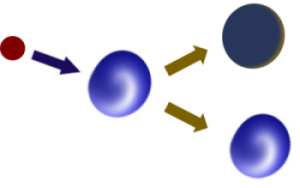Today’s our modern life, STRESS has become an inevitable part.
What does stress mean in our lives?
What is Stress?

According to Selye, “stress” in the body can be divided into:
– Stimuli from the external environment = “Stressor”
– Physiological reactions caused by stimuli = “Stress state”
Stress is represented as a red ball in the figure, and the rubber ball represents our mind and body. The stress state refers to the distortion within the body that occurs when various stressors are added. It is a state where the ball hits the rubber ball and causes it to indent.
Normally, even when the “stress ball indents the ball”, the reaction occurs immediately, and repair of the indented area is performed. Therefore, even if we are temporarily affected by stress, we can maintain our health (route of the diagonal upward arrow in the figure). Physiological function called “homeostasis” supports the function of returning to the original state.
Maintaining Health or Mooving on to Stress Disease
However, if this repair does not go well, it may remain indented (route of the diagonal downward arrow in the figure). This is the state of various stress-related diseases.
So, when does it remain indented? There are mainly three cases to consider.
- When stress is too great (such as major life events)
- When stress is not large individually but continues continuously (such as daily life stress, “daily hustless”)
- When resilience to stress is low (such as vulnerability of resilience)
1. When stress is significant (the figure shows a large stress ball):
This is the case when exposed to significant stressors such as disasters or trauma. In this case, recovery may be delayed or difficult.
2. When stress is not significant individually but continues continuously (the figure shows many small stress balls continuously hitting):
These are cases where minor stresses in daily life persist chronically over a long period. Unlike the first case, there is often no awareness of stress load, and as a result, coping may be delayed, gradually affecting the body.
3. When resilience is weak (the figure shows weak resilience of the rubber ball):
Even if stress is not significant or continuous, becoming ill may occur if resilience is weak. The difference in resilience determines whether a person can recover and maintain health or become ill due to stress.
Stress as “The Spice of Life”
According to Selye, stress is also called “the spice of life.”
Stress is not necessarily “bad.”
Just as moderate spices make dishes better, moderate stress makes life more flavorful. It is understandable that in environments without stimuli, suicide rates are high.
Whether stress leads to illness or becomes the spice of life depends on our skills as chefs. The approach varies depending on which of the above cases 1-3 is present. It is important to deal with it appropriately based on its characteristics.
(Kanbara K, LABs Psychosomatic Medicine, https://psychosom.net/column/stress, Aug. 2021)
Related Columns, Articles, and Research
- Psychosomatic Disorders: Diseases Related to Stress
- <Research> Stress-Related Disorders and Functional Physical Disorders
- <Research> Psychosomatic Examination of Risk Factors for Stress-Related Disease Onset
- <Research> Stress Profile
- <Research> Psychosomatic Monitoring and Stress Assessment in Daily Life <Is Interoceptive Sensation the Key?>
